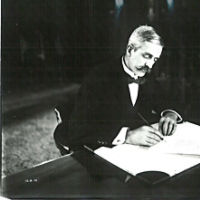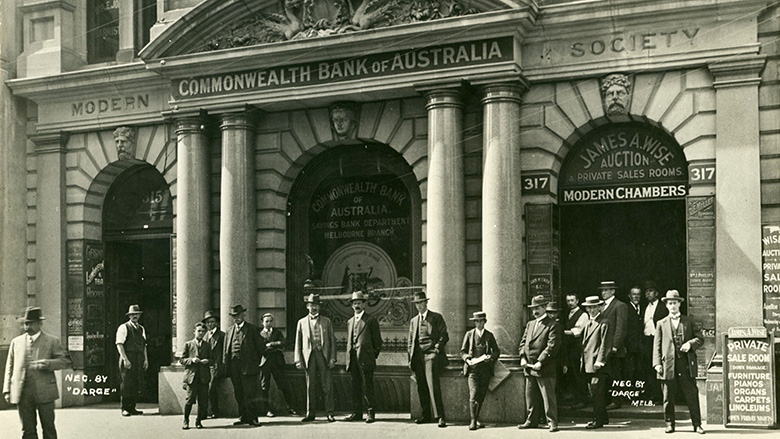Looking back over the 100 years since his death in June 1923, historians could now say that it was predictable and almost inevitable that Denison Miller would be handed the responsibility as the first Governor (equivalent to today’s CEO role) to establish the newly founded Commonwealth Bank.
Two-thirds through a career that eventually spanned almost half a century in banking, Miller knew on his appointment in 1912 everything there was to know about running such an important institution.
Having joined the country’s first and oldest bank – the Bank of New South Wales (BNSW) – straight after leaving school, he had worked at every level of the company, and managed branches across the country from Perth to Sydney before being elevated to the second most senior position in the organisation.
But even with that experience, knowledge and profile within the BNSW (which later became Westpac) Miller was largely unknown, certainly to the Australian public and even to the man who appointed him to lead CBA, then-Prime Minister Andrew Fisher. He was therefore no shoe-in for the job.
The perfect candidate
Miller’s qualities and abilities, though, were not in doubt as Fisher discovered in his conversations with people who knew Miller best. The new governor-to-be was industrious, hard-working, dedicated, considered, thoughtful, cautious but also innovative, determined and a calm leader who could be guaranteed to see the job through, no matter the challenges confronting him.
Fisher was impressed enough to offer Miller the post in May 1912, little more than six months after the legislation was passed by the new Labor government to establish the country’s first publicly-owned national bank.
And such was the importance and profile of the role that Miller was paid more than the PM who appointed him – 4000 pounds a year (equivalent to over half a million dollars) plus a generous travelling allowance for him to set up branches all over Australia.
As events were later to prove, Miller would be worth every pound, shilling and penny of his new salary during the 11 years he was to lead CBA.
 Denison Miller in his office at Australian Alliance Building in Melbourne, 1912 (Reserve Bank of Australia Archives)
Denison Miller in his office at Australian Alliance Building in Melbourne, 1912 (Reserve Bank of Australia Archives)
Early life
His rise to national prominence was a far cry from Fairy Meadow near Wollongong in New South Wales where he was born in 1860. Moving to Deniliquin at an early age, a town on the NSW/Victorian border where his father was the headmaster of the public school, Miller’s first job was as a junior clerk in the BNSW branch. His pay: 40 pounds per annum.
Six years later he transferred to the BNSW head office in Sydney from where stints in Western Australia, South Australia, Victoria as well as regional NSW followed. As he approached his 40th birthday, Miller was appointed in 1899 as assistant to the bank’s General Manager (a position in those days equivalent to Managing Director and CEO). Over the next 10 years, he was further elevated to the role of Metropolitan Inspector, in effect making him deputy to the General Manager. It was not surprising therefore – at least to the banking industry’s senior leaders at the time – that Miller was the ideal candidate for the Governor’s post at the CBA.
Giving back to Australia
As Miller became more widely known, it was his reassuring presence and long-standing experience that helped establish himself in the minds of the Australian public. That was particularly the case during WW1 and the national role he played in the fund-raising campaigns, but it was also evident in the care and attention he gave to staff, especially those who served overseas during the war.
 Governor Denison Miller lays the foundation stone for the Commonwealth Bank head office building on Martin Place, Sydney, 1913 (Reserve Bank of Australia Archives)
Governor Denison Miller lays the foundation stone for the Commonwealth Bank head office building on Martin Place, Sydney, 1913 (Reserve Bank of Australia Archives)
And for a man steeped in the paternalism of the Victorian and Edwardian age – an attitude that encompassed acts of charitable giving and supporting causes for the public good – Miller also dedicated himself to giving something back to the society that had served him so well.
Among the many organisations he supported and represented, he was vice-chairman of the Executive of the Hospital Saturday Fund in NSW, Life Governor of the Sydney Hospital and Royal Children’s Hospital, a benefactor of the Barnardo Scheme, the Society for the Prevention of Cruelty to Animals, the YMCA and the Girls’ Friendly Society.
He was also a keen golfer, hosting golf days and sporting carnivals for staff in the grounds of his family’s home in Coogee, and was President of the Australian Golf Club in Sydney.
In a life well-lived, he was knighted in 1920 for his service to Australia and as Governor of the CBA, an honour bestowed on him by the then Prince of Wales (later King Edward VIII) on the Prince’s tour of the country that same year.
Miller was married twice (widowed in 1890, re-married in 1895) and had eight children, two of whom pre-deceased him (one son in 1911 and a second, killed in action in France in 1917). He was survived by his second wife, Laura, and their six children.
Sir Denison Samuel King Miller, KCMG, born 8 March 1860 near Wollongong, NSW; died suddenly of heart disease aged 63, 6 June 1923, Coogee, Sydney, NSW.
Banner image: Denison Miller, circa 1912 (Reserve Bank of Australia Archives)
Go to CBA Newsroom for the latest news and announcements from Commonwealth Bank.





